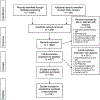Factors Associated With Receipt of Cognitive-Behavioral Therapy or Prolonged Exposure Therapy Among Individuals With PTSD
- PMID: 31010409
- PMCID: PMC6702958
- DOI: 10.1176/appi.ps.201800408
Factors Associated With Receipt of Cognitive-Behavioral Therapy or Prolonged Exposure Therapy Among Individuals With PTSD
Abstract
Objective: The aim of this study was to systematically review variables associated with initiation of trauma-centered cognitive-behavioral therapy (TC-CBT) among individuals with posttraumatic stress disorder (PTSD).
Methods: PubMed, PsycINFO, Web of Science, Published International Literature on Traumatic Stress (PILOTS), and Scopus were searched in a systematic manner up to 2018, and 26 relevant studies were recovered and analyzed.
Results: The average weighted initiation rate was 6% in larger hospital systems with a high rate of trauma and 28% in outpatient mental health settings (range 4%-83%). Older age (odds ratio [OR]=1.56, 95% confidence interval [CI]=0.51-1.61), female gender (OR=1.18, 95% CI=1.08-1.27), black or other racial-ethnic minority group (OR=1.16, 95% CI=1.03-1.28), Veterans Affairs PTSD service connection status (OR=2.30, 95% CI=2.18-2.42), mental health referral (OR=2.28, 95% CI=1.05-3.50), greater staff exposure to TC-CBT (OR=2.30, 95% CI=2.09-2.52), adaptability of TC-CBT to staff workflow (OR=4.66, 95% CI=1.60-7.72), greater PTSD severity (OR=1.46, 95% CI=1.13-1.78), and comorbid depression (OR=1.21, 95% CI=1.14-1.29) increased the likelihood of TC-CBT initiation, whereas delayed treatment reduced the likelihood of TC-CBT initiation (OR=0.93, 95% CI=0.92-0.95). Qualitative studies showed that mental health beliefs (stigma and lack of readiness), provider organizational factors (low availability, privacy issues), and patient lack of time (logistics) were perceived as barriers to initiation by patients and providers.
Conclusions: TC-CBT initiation increased among patients who were older and female. Initiation was also higher among providers who had more exposure to TC-CBT in their work environment and when TC-CBT fit into their existing workflow.
Keywords: Cognitive behavioral therapy; Posttraumatic stress disorder (PTSD; Prolonged Exposure Therapy; Treatment Initiation; behavioral health services utilization.
Figures
References
-
- Kessler RC: Posttraumatic stress disorder: the burden to the individual and to society. The Journal of clinical psychiatry 61 Suppl 5:4–12; discussion 3–4, 2000 - PubMed
-
- Affairs UDoV: Treatment of PTSD. Washington, DC: National Center for PTSD, 2018
-
- Goodson J, Helstrom A, Halpern JM, et al.: Treatment of Posttraumatic Stress Disorder in U.S. Combat Veterans: A Meta-Analytic Review. Psychol Rep 109:573–99, 2011 - PubMed
-
- Ho FY, Chan CS, Tang KN: Cognitive-behavioral therapy for sleep disturbances in treating posttraumatic stress disorder symptoms: A meta-analysis of randomized controlled trials. Clin Psychol Rev 43:90–102, 2016 - PubMed


